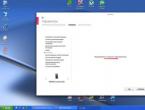Which file contains the license key. Getting a Windows key in Speccy
Lost product key (CD Key / activation code / serial number) is always an unpleasant problem. In such cases, you usually have to contact the developers or even spend money on purchasing new version programs. Well, the most common option is that the “key” on the Windows license sticker has been erased (which the author has encountered). What should you do if you don’t want to pay, but you need an activation code right now? The application is not fully functional and needs to be reinstalled? Luckily, there's a whole class free utilities on the restoration of "serials", the most famous of which are Windows Product Key Finder Pro And Keyfinder, about which below.

So, let's say you "lost" the key to a honestly purchased Windows or office suite Microsoft Office. In order to recognize it and save it at least in txt-file, one important condition is required: it must be “fished out” before uninstalling (removing) non-working software or formatting hard drive, because all keys are stored in encrypted form in the system registry and will be irretrievably lost. Therefore, after reading the article, without delay, check the software stickers and, if they are damaged, restore and save them necessary information, for example, on a flash drive.
Windows Product Key Finder Professional

This utility is simple and understandable even without special knowledge in English. After installation, in the open program window you will see decrypted activation codes for Windows 2000 / XP / Vista / 7 / 8 and, if available, MS Office XP / 2003 / 2007 / 2010 / 2013. It is not necessary to look for paper and pen, using the " buttons Save" And " Print"keys are instantly copied to text file or printed.
Free download from the official website Windows Product Key Finder .
Warning!
Despite all the "advantages", the program noticeably litters the system registry, so the best option- below.
Magical Jelly Bean Keyfinder

Perhaps the most advanced free key search engine in terms of capabilities is Keyfinder from developers from sunny Cyprus. Using the link below, I recommend downloading a registry-safe portable version of the program, which, when opened, will show all hidden “serials” in the right half of the window. It will also help restore registration data (username, product ID) and export information to a TXT / CSV file or to paper (see in the top panel " File"). By the way, the number of supported products, in addition to the Windows and Microsoft Office lines, is more than 300!
Download Magical Jelly Bean Keyfinder(distribution + portable-version).

Note: B Windows packages and the Office product key is a 25-character sequence of the form XXXXX-XXXXX-XXXXX-XXXXX-XXXXX. They can only activate the edition (version) of the software that is indicated on the license sticker, i.e. You cannot activate Windows 7 Professional using the Windows 7 Home key. Besides:
- Retail -activated by key Retail-a copy of the application on any, but only one computer. Retail-the key in the form of a sticker can be carefully attached to the system unit or laptop.
- OEM -key is used to activate one OEM-copies on the same PC on which it was first activated. OEM-sticker ( Certificate of Authenticity) is already glued to the body by the manufacturer.
Actually, that’s all, I’m sure you also successfully dealt with the copies and stickers.
Dmitriy dmitry_spb Evdokimov
Computers and laptops with the Windows 7 operating system preinstalled had a special sticker on which the product registration key was indicated.
This sticker has been removed in Windows 8 and 8.1. This was done for security purposes so that the system’s registration key could not be stolen. But there is one thing.
What if you suddenly need to reinstall? After all, to do this you will have to enter the key again.
Using the Producey program
Fortunately, extracting the registration key from activated Windows 8 and 8.1 is not a big problem. There are several ways to remove the key from the system. The simplest and most convenient is to use special program Producey. This utility is intended to extract activation keys from Microsoft software products.
Producey is completely free and very easy to use. All you need to do is simply install and run the program. The application supports retrieving the product identifier, registration key, and importing the received data into html format. You can also copy the key to the clipboard and save it to a regular .
Using a VBScript script
You can also extract the key from activated Windows using your home operating system. If you're interested in knowing where the key is located Windows activation in the system registry, namely in the HKLM/SOFTWARE/Microsoft/Windows NT/CurrentVersion/DigitalProductId branch.

Unfortunately, you won’t be able to view it directly, since it is stored in encrypted form. To decrypt it, you can use a ready-made VBScript script. You can download it from this link.

Unpack the archive with the script in any convenient place and run it by double-clicking. A window should appear showing the activation key of your operating system.
However, this trick will only work if your computer allows access to the server Windows scripts, otherwise you will receive an error message.
But it seems to me that using the Producey utility is much simpler and more convenient, especially since the proposed script only works on the Windows 7 and 8 operating system.
Need to download music from VK?
It would seem that it could be simpler than to carry out such an action, how to find out Windows key 8. But in fact, this is not an entirely easy task, since only the product code is displayed in the system properties, and not the key itself.
Why might this be needed?
Until a few years ago, it was common practice to place a sticker on back side laptop or inside system unit: you could easily look at it license key Windows 8. But since the value of the laptop form factor is its mobility, frequent friction with various surfaces quickly deteriorated the stickers, and the information on them became unreadable. And this could be critical if you did not prudently rewrite the key somewhere in a safe place.
After a little thought, manufacturers found a fairly simple and at the same time relatively reliable means for saving license data. It was decided to embed activation information into the BIOS - the primary subroutine responsible for launching and debugging the operation of all components and modules personal computer. But if something happens to hard drive And motherboard, then even after replacing them, the license will be lost.
Fortunately, the user has tools at his disposal to implement such a task as finding out the key Windows product 8. And this can be done in several ways. In general, this is an optional operation, but its usefulness can be greatly underestimated. So let's take a closer look at the available options.
Methods
You can find out the Windows 8 serial number both using the tools built into the operating system itself and using utilities from third-party developers. And it is worth noting that in the G8 itself there are several ways to do this, but some of them are extremely impractical, and others only partially cope with the task. We simply will not consider such untenable options.
So, let's start with the basic tool, and then consider several third-party ones.
Creating a file
The reader will have to create a small file that, when opened, will display the information of interest.
To do this, you will need to create a text document in any place convenient for the user.

Then open it and either enter it manually or copy and paste the following:
Set WshShell = CreateObject("WScript.Shell")
regKey = "HKLMSOFTWAREMicrosoftWindows NTCurrentVersion"
DigitalProductId = WshShell.RegRead(regKey & "DigitalProductId")
Win8ProductName = "Windows Product Name: " & WshShell.RegRead(regKey & "ProductName") & vbNewLine
Win8ProductID = "Windows Product ID: " & WshShell.RegRead(regKey & "ProductID") & vbNewLine
Win8ProductKey = ConvertToKey(DigitalProductId)
strProductKey = "Windows 8 Key: " & Win8ProductKey
Win8ProductID = Win8ProductName & Win8ProductID & strProductKey
MsgBox(Win8ProductKey)
MsgBox(Win8ProductID)
Function ConvertToKey(regKey)
Const KeyOffset = 52
isWin8 = (regKey(66) 6) And 1
regKey(66) = (regKey(66) And &HF7) Or ((isWin8 And 2) * 4)
Chars = "BCDFGHJKMPQRTVWXY2346789"
Cur = regKey(y + KeyOffset) + Cur
regKey(y + KeyOffset) = (Cur 24)
Cur = Cur Mod 24
Loop While y >= 0
winKeyOutput = Mid(Chars, Cur + 1, 1) & winKeyOutput
Loop While j >= 0
If (isWin8 = 1) Then
keypart1 = Mid(winKeyOutput, 2, Last)
winKeyOutput = Replace(winKeyOutput, keypart1, keypart1 & insert, 2, 1, 0)
If Last = 0 Then winKeyOutput = insert & winKeyOutput
a = Mid(winKeyOutput, 1, 5)
b = Mid(winKeyOutput, 6, 5)
c = Mid(winKeyOutput, 11, 5)
d = Mid(winKeyOutput, 16, 5)
e = Mid(winKeyOutput, 21, 5)
ConvertToKey = a & "-" & b & "-" & c & "-" & d & "-" & e
Then you need to select “File” and find the “Save As” option.

First of all, in the window that opens, you will need to select “All files” in the “File type” column. Then you will need to fill in the “Name” field. In principle, you can name the file whatever you want, but the main thing is to add the following at the end: .vbs. It is when this extension is specified that everything will work, but if this is not done, then nothing will work.

Once the above is done and the information is saved, you can open the file. First, a window will appear exclusively with the key, and after clicking “OK,” a second window will appear on the screen, where the information will be presented in more detail.


Applications
To find out information about the OS key, there are both specialized utilities and those in which such tools are only included as a small part of the available capabilities.
Among the specialized utilities, we can mention the tiny program ProduKey, the sole purpose of which was to establish the value of the activation keys of all possible products from Microsoft. If the reader has Microsoft Office, then its license key will be displayed in the program. The application is free and can be easily and simply downloaded on the developers’ website in the appropriate section or by immediately following the link.
Open the archive, launch the utility and look at what interests you.


Similar licensing information can also be obtained from applications such as Everest, AIDA64 or Free PC Audit. The first is the predecessor of the second, but what they have in common is that they are both paid. The latter is their analogue and has almost the same functions as the first two, but is distributed free of charge. You can get it on the developers’ website or by following the link.
After downloading, you just need to open the application and wait until it collects all the necessary information.

After scanning is completed, the license key will be visible immediately - on the first page in the corresponding column.

How to find out the Windows 8 key: Video
How can I find out the activation key for my operating system? This question can arise only in two cases. The first is if you need to reinstall the system and you didn’t have the disk. If you have a laptop, then system disk you couldn't have it, because... on Windows laptops should already be installed. The license key is usually glued to the bottom of the case or embedded in the BIOS.
At the time of buying desktop computer They also don’t always give you a disk with the distribution, but if they do, users often throw it away and only remember about it when it’s time to repair the computer.
And the second case is if you updated your system to Windows 10, from Windows 7 or 8, and you didn’t see any key, because it was installed automatically.
In general, it doesn’t matter how you installed the system or where the disk went, what’s important is that it’s not there, and there’s no activation key either. But there are no hopeless situations. And now we will make sure of this.
How to find out the operating system activation keyWindows
What is an activation keyWindows?
If your operating room Windows system licensed, then to activate it a special license key is used, or, as it is also called, a product key.
The activation key consists of 25 characters in the form of capital letters of the Latin alphabet and numbers, divided into 5 groups of 5 characters:
XXXXX-XXXXX-XXXXX-XXXXX-XXXXX
Checking activation using the command line
To do this you need to open command line on behalf of administrator and type one of the commands below:
- slmgr /dli— display information about the license.
- slmgr/dlv— Displays detailed information about the license.
- slmgr /xpr— display the activation end date.
- vbs /rearm— activation reset, return to trial state.
- vbs/ipk— installation of the product key.
- vbs/skms— setting the KMS name or port.
- vbs/ato- Windows activation.
- vbs/upk— deleting the product key.
- vbs/cpky— removing the product key from the registry (preventing theft).
- At the moment we only need the first three commands.
- If we write a command slmgr /dli and press the button Enter

It is not at all necessary to know the license code that was used to activate the operating system in Windows 10. OS activation, in most cases, is automatic. Despite this, for some reason many users want to find out how to find out the Windows 10 product key. This is an urgent task for users who were lucky enough to purchase a new device based on the “Ten”.
This article is a guide that provides information collected across the global network that will help you find out the license key used to activate Windows 10.
The instructions discuss all options for achieving the goal: both through tools integrated into the operating system (extended command line - PowerShell, a ready-made VBScrit script created to decrypt registry files in order to extract from there the key with which Windows 10 was activated), and using utilities from third-party developers (the ProduKey utility, developed by the creator of several dozen tiny information applications). It would be appropriate to mention such things as:
- the reason why it seems similar applications display different data;
- a method for visualizing an OEM key in UEFI (applicable only for Windows 10 that was initially installed).
Users who acquired Windows 10 by upgrading from a licensed “seven” or “eight” do not need to know the licensed operating system - it activates itself upon first startup, if there is Internet access, or immediately after a connection to the global information network. In the case of a clean installation of the OS from bootable media, at the stage of entering the license code, you should click “I don’t have a product key,” which Microsoft writes in the text block.
Activation is automatically and irrevocably linked to the user’s computer based on unique identifier, based on the hardware configuration of the equipment, and with reference to account Microsoft. The password entry form is required to be filled out only for people who decide to purchase the Retail edition of the operating system. Owners of licensed versions of “seven” and “eight” should refer to the key that was used to activate these editions of Windows.
We look at the key via PowerShell
Let's start with an option to solve the problem without resorting to downloading third-party software. It consists of using a tool integrated into Windows environment 10, called PowerShell. There is no special command for extracting the activation code from registry files in encrypted form, but one of the enthusiasts wrote a script that runs in the Vbasic environment to solve this problem.
1. Download the finished script.
2. Using the search bar, call PowerShell with administrator privileges.
In the extended command line text field, execute “Set-ExecutionPolicy RemoteSigned”.
We confirm the launch of the command by clicking on the “Y” and “Enter” buttons.
We import the downloaded file by executing the line “Import-Module prodect_key.ps1”.
prodect_key.ps1 - here before the file name we write the full path to it.

We call the “Get-WindowsKey” command to export the key with its subsequent visualization if it is not prompted to save the key in a text file.
The required information will appear in the last line of the command line.
Viewing keys in the ShowKeyPlus application window
The utility is notable for the fact that it displays the key of the operating system currently used on the PC, separately shows the UEFI key and is able to retrieve information about the license of any previous one. Windows versions, even if its files are in the Windows.old folder. The program functions without installation into the system; it is downloaded from the resource at: github.com/Superfly-Inc/ShowKeyPlus/releases.
Using ShowKeyPlus is a pleasure: let’s launch executable file and get all the necessary information.

- Installed Key - license key for running Windows 10.
- OEM Key - shows the pre-installed Windows key, if there was one, or a message that the OEM key is not provided.
This information can be exported to one of the supported text formats for archiving purposes. This is done using the Save button.
Here lies the secret that various programs display different information about the Windows 10 key: some read it from the registry (the key of the currently functioning operating system, while others export it from UEFI.
ProduKey app
Producey is a program similar to the previous one, the only task of which is to export and display Product Key current Windows. You can download it from www.nirsoft.net/utils/product_cd_key_viewer.html. The utility works without installation; you can run it directly from the archive. After launch, the window displays the product ID, its key and name. The program is applicable not only to operating systems from Microsoft, but also to office suites and other software products of the same corporation.

Extracting OEM code from UEFI
Regardless of which OS currently controls the operation of your computer, if Windows 10 was installed on it when you purchased the device, the OEM key for it was sewn into the UEFI of the laptop or motherboard. To extract it, you need to call the command line and execute the line: “wmic path softwarelicensingservice get OA3xOriginalProductKey”.
If such a code is not present in UEFI, an empty line will appear on the screen, and if it is present, the OEM character sequence may differ from the activation key used in the current Windows 10. The OEM key can also be used to return the originally installed version of the operating system.
To solve the problem, there are several more common ones (for example, Speccy) and an equally large number of specialized programs, but the methods discussed are sufficient for any user.




